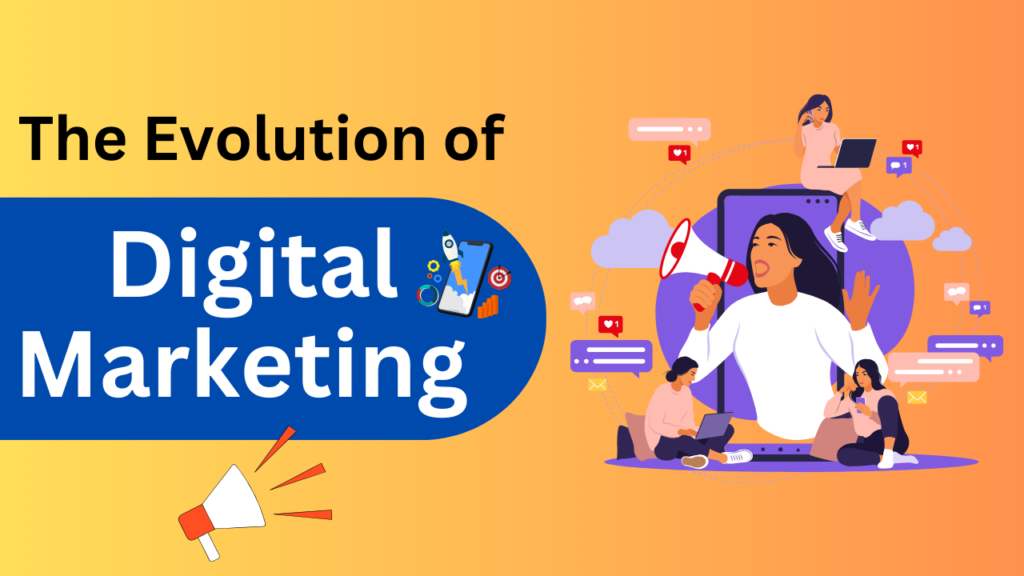Digital marketing has transformed dramatically over the past few decades. As technology has evolved, so too have the strategies and tools used to engage consumers. This article explores the evolution of digital marketing, tracing its development from the early days of the internet to the sophisticated techniques used today. By understanding this evolution, businesses can better navigate the digital landscape and connect with their audiences.
The Birth of Digital Marketing
The Early Days of the Internet
The roots of digital marketing can be traced back to the early 1990s, when the internet began to gain popularity. Websites were rudimentary, often consisting of static HTML pages with limited functionality. In this early phase, businesses primarily used email as a means of reaching customers. Digital MarketingThe first clickable banner ad appeared in 1994, marking a significant milestone in digital advertising.
The Emergence of Search Engines
As the internet grew, so did the need for effective search tools. The launch of search engines like Yahoo! and Google in the mid-1990s changed the way people navigated the web. Businesses quickly recognized the potential of search engine optimization (SEO) to enhance visibility and drive traffic. Early SEO practices focused on keyword placement and basic link-building strategies.

The Rise of Social Media
Social Media’s Impact on Marketing
The mid-2000s witnessed the rise of social media platforms such as Facebook, Twitter, and LinkedIn. These platforms provided new avenues for brands to engage with consumers directly. Digital Marketing Social media marketing became a crucial component of digital marketing strategies, allowing businesses to interact with their audience in real time.
User-Generated Content and Engagement
The emergence of social media also led to the rise of user-generated content. Consumers began to share their experiences and opinions online, influencing brand perceptions. Digital Marketing Businesses quickly learned the importance of engaging with their audience, responding to comments, and building a community around their brand.
The Era of Content Marketing
The Shift Toward Valuable Content
By the early 2010s, content marketing emerged as a powerful strategy. Brands recognized that providing valuable, relevant content could attract and retain customers. Blogs, videos, infographics, and podcasts became essential tools for Digital Marketing engaging audiences and establishing authority in specific niches.
The Importance of Storytelling
Effective content marketing relies on storytelling. Brands began crafting narratives that resonated with consumers, helping them connect emotionally. This approach not only improved customer engagement but also fostered brand loyalty. Companies that embraced storytelling successfully differentiated themselves in a crowded marketplace.
The Advent of Mobile Marketing
The Shift to Mobile Devices
As smartphones gained popularity, mobile marketing became increasingly important. In 2014, mobile web traffic surpassed desktop traffic for the first time, prompting businesses to optimize their websites for mobile users. Digital Marketing strategies included responsive design, mobile apps, and location-based advertising.
The Role of SMS and Push Notifications
Text messaging and push notifications emerged as effective tools for reaching consumers directly. Brands utilized SMS marketing to send promotions and updates, while push notifications on mobile apps kept users informed and engaged. These strategies allowed for timely communication and improved customer interaction.
The Rise of Data-Driven Marketing
The Importance of Analytics
The late 2010s marked a shift toward data-driven marketing. Businesses began leveraging analytics tools to gather insights about consumer behavior and preferences. This data-driven approach enabled marketers to make informed decisions, optimize campaigns, and measure their effectiveness in real time.
Personalization and Targeting
With access to vast amounts of data, marketers could create personalized experiences for their customers. Targeted advertising based on demographics, interests, and online behavior became common practice in Digital Marketing. This level of personalization improved engagement and conversion rates, leading to more effective marketing strategies.
The Age of Automation and AI
Marketing Automation Tools
The advent of marketing automation tools revolutionized how businesses manage their Digital Marketing efforts. Platforms like HubSpot and Marketo allowed companies to automate tasks such as email marketing, social media posting, and lead nurturing. Automation freed up valuable time for marketers to focus on strategy and creativity.
The Role of Artificial Intelligence
Artificial intelligence (AI) has become a game-changer in Digital Marketing. AI-driven tools enable businesses to analyze consumer data, predict trends, and deliver personalized experiences at scale. Chatbots, for example, provide instant customer support, enhancing user experience and satisfaction.
The Future of Digital Marketing
Emerging Technologies
Looking ahead, emerging technologies such as virtual reality (VR) and augmented reality (AR) are set to shape the future of Digital Marketing. Brands are experimenting with immersive experiences that allow consumers to interact with products in new ways. These technologies offer exciting opportunities for engagement and storytelling.
Ethical Considerations and Privacy
As Digital Marketing evolves, ethical considerations around data privacy are becoming increasingly important. Consumers are more aware of how their data is used, leading to demands for transparency and control. Marketers must navigate these concerns by implementing ethical practices and prioritizing customer trust.
Conclusion: Adapting to Change in Digital Marketing
The evolution of digital marketing reflects the dynamic nature of technology and consumer behavior. From its humble beginnings in the 1990s to the data-driven, automated landscape of today, Digital Marketing continues to adapt and innovate. Businesses that embrace these changes and prioritize customer engagement will thrive in an ever-evolving digital world.
By understanding the historical context of digital marketing, companies can develop strategies that resonate with their audiences and drive success in the future. The journey of digital marketing is far from over, and its continued evolution promises exciting opportunities for brands and consumers alike.
